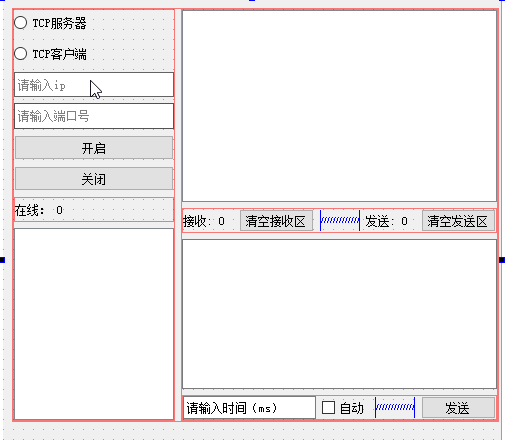QT之TCP通訊
QT中可以通過TCP協議讓伺服器和客戶端之間行通訊。所以下面我就圍繞伺服器和客戶端來寫。
這是我們寫伺服器和客戶端的具體流程:
A、伺服器:
1.建立QTcpServer物件
2.啟動伺服器(監聽)呼叫成員方法listen(QHostAddress::Any,埠號)
3.當有客戶端連結時候會發送newConnection訊號,觸發槽函式接受連結(得到一個與客戶端通訊的套接字QTcpSocket)
4.QTcpsocket傳送資料用成員方法write,
5.讀資料當客戶端有資料來,QTcpSocket物件就會發送readyRead訊號,關聯槽函式讀取資料
B、客戶端 :
1.建立QTcpSocket物件
2.連結伺服器connectToHost(QHostAddress("ip"),埠號)
3.QTcpsocket傳送資料用成員方法write,
4.讀資料當對方有資料來,QTcpSocket物件就會發送readyRead訊號,關聯槽函式讀取資料
我們需要呼叫到的標頭檔案有兩個:
#include <QTcpServer> #include <QTcpSocket>
我們先要在工程檔案中加入network
QT += core gui network
下面我們來看看伺服器程式步驟:
1、初始化伺服器server物件
mServer = new QTcpServer();
2、啟動監聽伺服器
mServer->listen(QHostAddress::Any,9988);//9988為埠號
3、當有客戶端連結時候會發送newConnection訊號,觸發槽函式接受連結(得到一個與客戶端通訊的套接字QTcpSocket)
connect(mServer,SIGNAL(newConnection()),this,SLOT(new_client())); mSocket = mServer->nextPendingConnection();//與客戶端通訊的套接字
4、傳送資料
mSocket->write(msg.toUtf8());
5、讀資料當客戶端有資料來,QTcpSocket物件就會發送readyRead訊號,關聯槽函式讀取資料
connect(mSocket,SIGNAL(readyRead()),this,SLOT(read_client_data()));
6、連線多個客戶端
//可以實現同時讀取多個客戶端傳送過來的訊息 QTcpSocket *obj = (QTcpSocket*)sender();
7、檢測掉線
connect(mSocket,SIGNAL(disconnected()),this,SLOT(client_dis())); //檢測掉線訊號
下面是伺服器的實現的具體程式碼:

1 #include "tcpserver.h"
2 #include "ui_tcpserver.h"
3 #include <QDebug>
4 TcpServer::TcpServer(QWidget *parent) :
5 QMainWindow(parent),
6 ui(new Ui::TcpServer)
7 {
8 ui->setupUi(this);
9 //初始化伺服器server物件
10 mServer = new QTcpServer();
11 //關聯客戶端連線訊號newConnection
12 connect(mServer,SIGNAL(newConnection()),this,SLOT(new_client())); //連線客戶端
13 //啟動伺服器監聽
14 mServer->listen(QHostAddress::Any,9988);
15
16 }
17
18 TcpServer::~TcpServer()
19 {
20 delete ui;
21 }
22
23 void TcpServer::new_client()
24 {
25 qDebug()<<"新客戶段連線";
26 mSocket = mServer->nextPendingConnection();//與客戶端通訊的套接字
27 //關聯接收客戶端資料訊號readyRead訊號(客戶端有資料就會發readyRead訊號)
28 connect(mSocket,SIGNAL(readyRead()),this,SLOT(read_client_data()));
29 //檢測掉線訊號
30 connect(mSocket,SIGNAL(disconnected()),this,SLOT(client_dis()));
31
32 }
33
34 void TcpServer::read_client_data()
35 {
36 //可以實現同時讀取多個客戶端傳送過來的訊息
37 QTcpSocket *obj = (QTcpSocket*)sender();
38 QString msg = obj->readAll();
39 qDebug()<<msg;
40 }
41
42 void TcpServer::client_dis()
43 {
44 QTcpSocket *obj = (QTcpSocket*)sender();//掉線物件
45 qDebug()<<obj->peerAddress().toString();//打印出掉線物件的ip
46 }

說完伺服器那我們繼續來看看客戶端是怎麼實現的:
1、建立QTcpSocket物件
mSocket = new QTcpSocket();
2、連結伺服器connectToHost(QHostAddress("ip"),埠號),連線伺服器ip和埠號
mSocket->connectToHost(ui->ipEdit->text(),ui->portEdit->text().toInt()); //ui->ipEdit->text():ip,ui->portEdit->text().toInt():埠號
3、傳送資料
//取傳送資訊編輯框內容 QString msg = ui->sendEdit->toPlainText(); mSocket->write(msg.toUtf8());//轉編碼
4、檢測連結成功訊號關聯槽函式
connect(mSocket,SIGNAL(connected()),this,SLOT(connect_suc()));
5、檢測掉線訊號
connect(mSocket,SIGNAL(disconnected()),this,SLOT(client_dis()));
6、伺服器和客戶端關閉都可以使用close
mSocket->close();
這是客戶端實現的具體程式碼

1 #include "tcpclient.h"
2 #include "ui_tcpclient.h"
3 #include <QDebug>
4 TcpClient::TcpClient(QWidget *parent) :
5 QMainWindow(parent),
6 ui(new Ui::TcpClient)
7 {
8 ui->setupUi(this);
9 //初始化套接字物件
10 mSocket = new QTcpSocket();
11 //關聯資料訊號
12 connect(mSocket,SIGNAL(readyRead()),this,SLOT(read_data()));
13
14 }
15
16 TcpClient::~TcpClient()
17 {
18 delete ui;
19 }
20
21 void TcpClient::read_data()
22 {
23 QString msg = mSocket->readAll();
24 qDebug()<<msg;
25 }
26
27 void TcpClient::on_btn_connectServer_clicked()
28 {
29 //檢測連結成功訊號關聯槽函式
30 connect(mSocket,SIGNAL(connected()),this,SLOT(connect_suc()));
31 //檢測掉線訊號
32 connect(mSocket,SIGNAL(disconnected()),this,SLOT(client_dis()));
33 //連線伺服器,設定ip和埠號
34 mSocket->connectToHost(ui->ipEdit->text(),ui->portEdit->text().toInt());
35
36 }
37
38 void TcpClient::on_btn_send_clicked()
39 {
40 //取傳送資訊編輯框內容
41 QString msg = ui->sendEdit->toPlainText();
42 mSocket->write(msg.toUtf8());//轉編碼
43 }
44
45 void TcpClient::connect_suc()
46 {
47 ui->btn_connectServer->setEnabled(false);//如果連線成功則連線按鈕不能按下
48 }
49 void TcpClient::client_dis()
50 {
51 ui->btn_connectServer->setEnabled(true);//如果連線沒有成功則連線按鈕還可以按下
52 }

這是伺服器和客戶端分開兩個資料夾寫的程式,在這裡我也實現了伺服器和客戶端寫在同一個檔案中
具體程式碼如下:
標頭檔案:tcpapp.h
 View Code
View Code
原始檔:tcpapp.cpp
 View Code
View Code
介面檔案tcpapp.ui如下圖

此外這裡還使用到了容器,在這裡講講容器的使用
1、定義容器物件
QVector<QTcpSocket*> clients; //儲存所有線上客戶端(容器)
解釋:QTcpSocke* 容器的型別
clients 容器名
2、往容器中新增成員
//上線使用者新增到客戶列表容器 clients.append(mSocket);
3、尋找某個成員在容器中位置
int row = clients.indexOf(obj);//找到掉線物件的內容所在的行
4、從容器中刪除成員
clients.remove(row);//從容器中刪除成員
鑑於本人才疏學淺,所以其中不免有遺漏或者錯誤,懇請各位博友批評指正。
QT中可以通過TCP協議讓伺服器和客戶端之間行通訊。所以下面我就圍繞伺服器和客戶端來寫。
這是我們寫伺服器和客戶端的具體流程:
A、伺服器:
1.建立QTcpServer物件
2.啟動伺服器(監聽)呼叫成員方法listen(QHostAddress::Any,埠號)
3.當有客戶端連結時候會發送newConnection訊號,觸發槽函式接受連結(得到一個與客戶端通訊的套接字QTcpSocket)
4.QTcpsocket傳送資料用成員方法write,
5.讀資料當客戶端有資料來,QTcpSocket物件就會發送readyRead訊號,關聯槽函式讀取資料
B、客戶端 :
1.建立QTcpSocket物件
2.連結伺服器connectToHost(QHostAddress("ip"),埠號)
3.QTcpsocket傳送資料用成員方法write,
4.讀資料當對方有資料來,QTcpSocket物件就會發送readyRead訊號,關聯槽函式讀取資料
我們需要呼叫到的標頭檔案有兩個:
#include <QTcpServer> #include <QTcpSocket>
我們先要在工程檔案中加入network
QT += core gui network
下面我們來看看伺服器程式步驟:
1、初始化伺服器server物件
mServer = new QTcpServer();
2、啟動監聽伺服器
mServer->listen(QHostAddress::Any,9988);//9988為埠號
3、當有客戶端連結時候會發送newConnection訊號,觸發槽函式接受連結(得到一個與客戶端通訊的套接字QTcpSocket)
connect(mServer,SIGNAL(newConnection()),this,SLOT(new_client())); mSocket = mServer->nextPendingConnection();//與客戶端通訊的套接字
4、傳送資料
mSocket->write(msg.toUtf8());
5、讀資料當客戶端有資料來,QTcpSocket物件就會發送readyRead訊號,關聯槽函式讀取資料
connect(mSocket,SIGNAL(readyRead()),this,SLOT(read_client_data()));
6、連線多個客戶端
//可以實現同時讀取多個客戶端傳送過來的訊息 QTcpSocket *obj = (QTcpSocket*)sender();
7、檢測掉線
connect(mSocket,SIGNAL(disconnected()),this,SLOT(client_dis())); //檢測掉線訊號
下面是伺服器的實現的具體程式碼:

1 #include "tcpserver.h"
2 #include "ui_tcpserver.h"
3 #include <QDebug>
4 TcpServer::TcpServer(QWidget *parent) :
5 QMainWindow(parent),
6 ui(new Ui::TcpServer)
7 {
8 ui->setupUi(this);
9 //初始化伺服器server物件
10 mServer = new QTcpServer();
11 //關聯客戶端連線訊號newConnection
12 connect(mServer,SIGNAL(newConnection()),this,SLOT(new_client())); //連線客戶端
13 //啟動伺服器監聽
14 mServer->listen(QHostAddress::Any,9988);
15
16 }
17
18 TcpServer::~TcpServer()
19 {
20 delete ui;
21 }
22
23 void TcpServer::new_client()
24 {
25 qDebug()<<"新客戶段連線";
26 mSocket = mServer->nextPendingConnection();//與客戶端通訊的套接字
27 //關聯接收客戶端資料訊號readyRead訊號(客戶端有資料就會發readyRead訊號)
28 connect(mSocket,SIGNAL(readyRead()),this,SLOT(read_client_data()));
29 //檢測掉線訊號
30 connect(mSocket,SIGNAL(disconnected()),this,SLOT(client_dis()));
31
32 }
33
34 void TcpServer::read_client_data()
35 {
36 //可以實現同時讀取多個客戶端傳送過來的訊息
37 QTcpSocket *obj = (QTcpSocket*)sender();
38 QString msg = obj->readAll();
39 qDebug()<<msg;
40 }
41
42 void TcpServer::client_dis()
43 {
44 QTcpSocket *obj = (QTcpSocket*)sender();//掉線物件
45 qDebug()<<obj->peerAddress().toString();//打印出掉線物件的ip
46 }

說完伺服器那我們繼續來看看客戶端是怎麼實現的:
1、建立QTcpSocket物件
mSocket = new QTcpSocket();
2、連結伺服器connectToHost(QHostAddress("ip"),埠號),連線伺服器ip和埠號
mSocket->connectToHost(ui->ipEdit->text(),ui->portEdit->text().toInt()); //ui->ipEdit->text():ip,ui->portEdit->text().toInt():埠號
3、傳送資料
//取傳送資訊編輯框內容 QString msg = ui->sendEdit->toPlainText(); mSocket->write(msg.toUtf8());//轉編碼
4、檢測連結成功訊號關聯槽函式
connect(mSocket,SIGNAL(connected()),this,SLOT(connect_suc()));
5、檢測掉線訊號
connect(mSocket,SIGNAL(disconnected()),this,SLOT(client_dis()));
6、伺服器和客戶端關閉都可以使用close
mSocket->close();
這是客戶端實現的具體程式碼

1 #include "tcpclient.h"
2 #include "ui_tcpclient.h"
3 #include <QDebug>
4 TcpClient::TcpClient(QWidget *parent) :
5 QMainWindow(parent),
6 ui(new Ui::TcpClient)
7 {
8 ui->setupUi(this);
9 //初始化套接字物件
10 mSocket = new QTcpSocket();
11 //關聯資料訊號
12 connect(mSocket,SIGNAL(readyRead()),this,SLOT(read_data()));
13
14 }
15
16 TcpClient::~TcpClient()
17 {
18 delete ui;
19 }
20
21 void TcpClient::read_data()
22 {
23 QString msg = mSocket->readAll();
24 qDebug()<<msg;
25 }
26
27 void TcpClient::on_btn_connectServer_clicked()
28 {
29 //檢測連結成功訊號關聯槽函式
30 connect(mSocket,SIGNAL(connected()),this,SLOT(connect_suc()));
31 //檢測掉線訊號
32 connect(mSocket,SIGNAL(disconnected()),this,SLOT(client_dis()));
33 //連線伺服器,設定ip和埠號
34 mSocket->connectToHost(ui->ipEdit->text(),ui->portEdit->text().toInt());
35
36 }
37
38 void TcpClient::on_btn_send_clicked()
39 {
40 //取傳送資訊編輯框內容
41 QString msg = ui->sendEdit->toPlainText();
42 mSocket->write(msg.toUtf8());//轉編碼
43 }
44
45 void TcpClient::connect_suc()
46 {
47 ui->btn_connectServer->setEnabled(false);//如果連線成功則連線按鈕不能按下
48 }
49 void TcpClient::client_dis()
50 {
51 ui->btn_connectServer->setEnabled(true);//如果連線沒有成功則連線按鈕還可以按下
52 }

這是伺服器和客戶端分開兩個資料夾寫的程式,在這裡我也實現了伺服器和客戶端寫在同一個檔案中
具體程式碼如下:
標頭檔案:tcpapp.h
 View Code
View Code
原始檔:tcpapp.cpp
 View Code
View Code
介面檔案tcpapp.ui如下圖

此外這裡還使用到了容器,在這裡講講容器的使用
1、定義容器物件
QVector<QTcpSocket*> clients; //儲存所有線上客戶端(容器)
解釋:QTcpSocke* 容器的型別
clients 容器名
2、往容器中新增成員
//上線使用者新增到客戶列表容器 clients.append(mSocket);
3、尋找某個成員在容器中位置
int row = clients.indexOf(obj);//找到掉線物件的內容所在的行
4、從容器中刪除成員
clients.remove(row);//從容器中刪除成員
